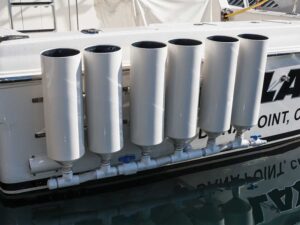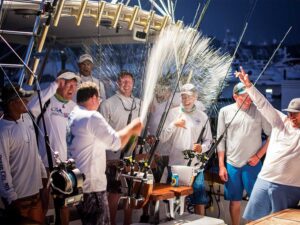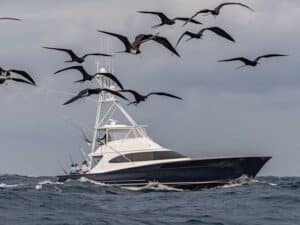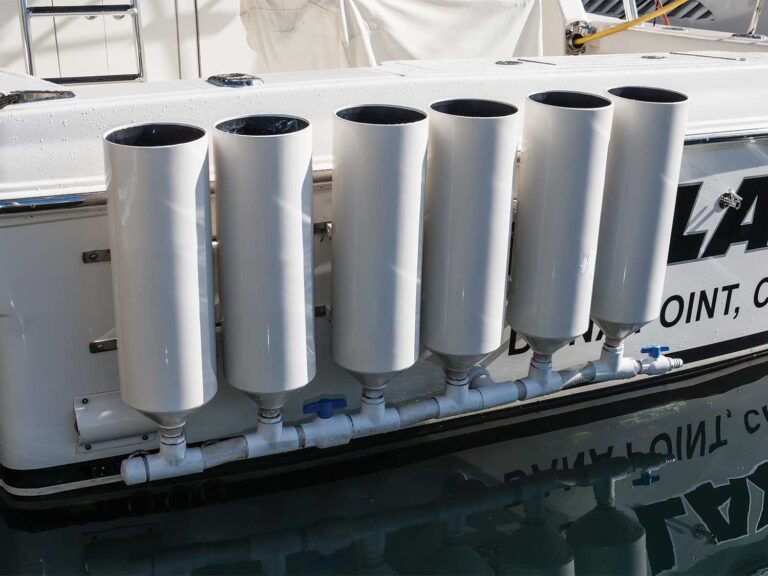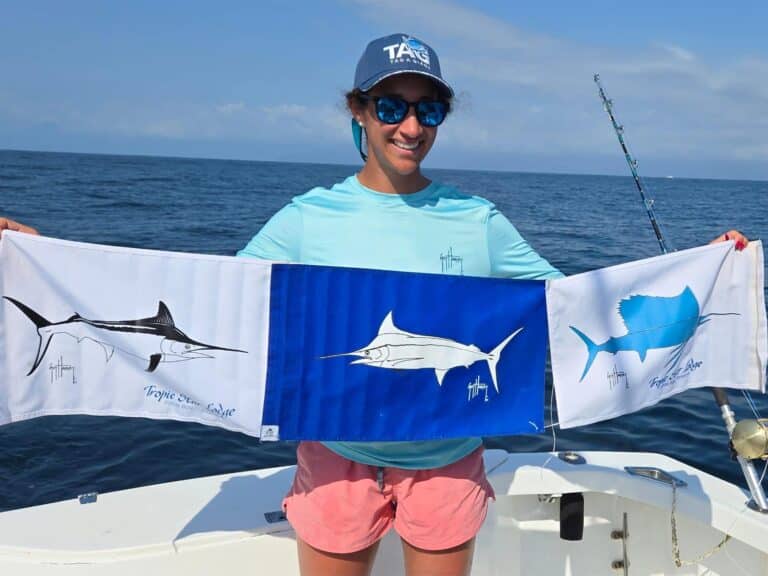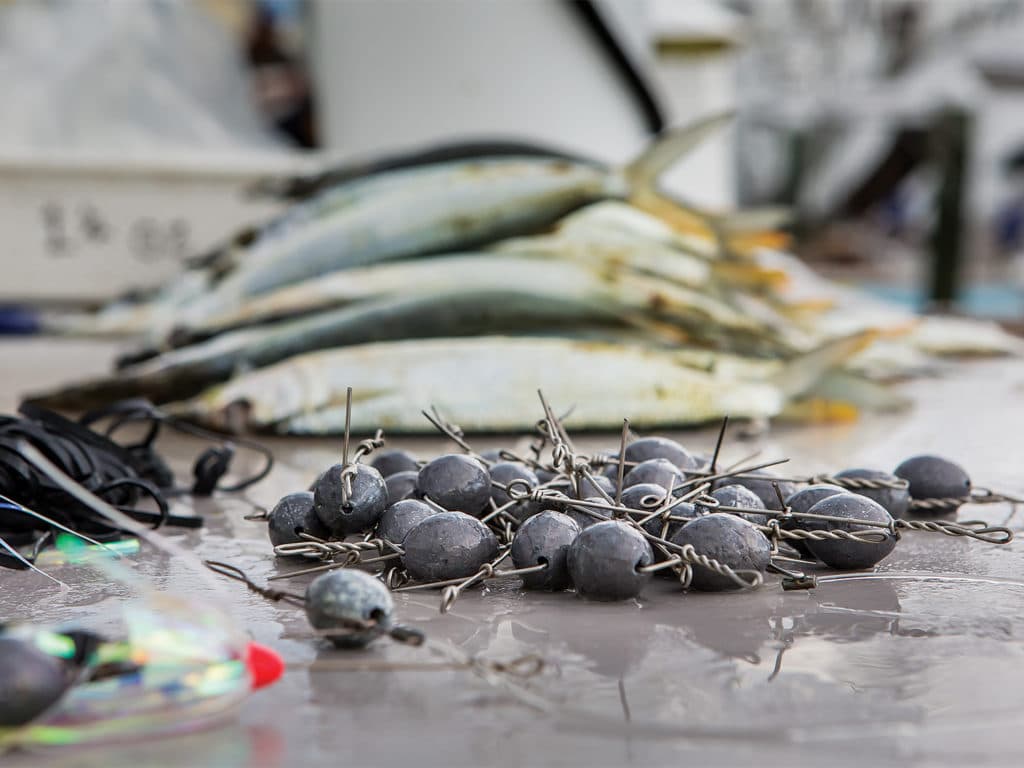
There is absolutely no question on how effective dredges are in helping us to raise billfish. This is especially true when it comes to smaller species—sailfish, white marlin and striped marlin—that generally work together to corral bait into a ball in order to pick them off one by one. And over the years, even blue marlin fishermen have taken a liking to dredges, noticing their effectiveness in raising fish from the depths.
In review, a dredge is a subsurface teaser that looks much like a baitball swimming behind your boat. Typically composed of six arms and fashioned in an umbrellalike frame that can hold 12 baits, most crews pull anywhere from two to four tiers of these frames to create a larger baitball illusion to help draw in hungry billfish.
A dredge requires constant work from the crew, especially if the baits are going au naturel. From the almost endless prepping the day before to switching out “tired,” clipped or washed-out baits throughout the day, the natural-bait dredge is high-maintenance. Almost primarily made up entirely of mullet and/or ballyhoo, it takes experience to put them together and know when to replace them. However, over the years we have watched the progression of artificial dredges, and some might even argue that they are proving to be nearly as effective as natural dredges. Nearly.
Watch: We show you the fastest way to rig a mullet for the dredge in this video.
The mid-Atlantic region of the US is home to some of the largest billfish tournaments in the world, and they offer numerous release points for the taking, so, if you aren’t pulling dredges, there’s a real chance you aren’t competing. This holds true anywhere in the world where you are targeting billfish by the numbers, with only a few exceptions. The rule used to be the same for this type of catch-as-many-as-you-can fishery: Pull two big, natural-bait dredges. But with the advances in artificial-dredge baits, we are seeing a lot of top crews opting to use one artificial dredge and one natural dredge. Some are even mixing natural baits into their artificials as well. And because pulling three-tiered, all-natural dredges gets expensive quick, especially at $5 per mullet, some crews are even beginning to swear by their favorite artificial dredges.
Natural vs. Imitation
There are situations where you absolutely should pull natural dredges: when you are looking to rack up impressive release numbers with sailfish and/or white marlin while dead-bait trolling. When involved in this type of activity, you are not fishing alone and are guaranteed to end up in the fleet at some point. The power natural dredges have over artificial dredges in raising and holding fish in your spread is unmatched, especially at the slower 4- to 6-knot speeds we troll when targeting sails and whites that are keen on balling bait.
If you plan to fish side-by-side in a sailfish tournament with artificial dredges against a boat that is pulling all naturals, then the odds are high you will be out-fished. Sorry. But if you are traveling abroad and unable to bring enough bait with you to support the unending dredge rigging, or are going to be fishing primarily all by your lonesome with little competition, then artificial dredges come in handy. Most crews feel it is better to have a fake dredge than no dredge at all when faced with that alternative. If you must eke out your dead-bait situation, then by all means mix the two and get the best of both worlds while also stretching your bait supply.
Artificial dredges certainly do have their time and place, and it couldn’t hurt to have a couple of them rigged and ready. Unfortunately, dredges do go away from time to time, either by an accidental break-off, from a hungry mako, or even an overaggressive billfish that piles on it out of nowhere and then swims away, wearing it like a party hat. Either way, these instances exemplify why having a backup artificial dredge ready to fire out without skipping a beat can save you when you’re in the heat of the bite.
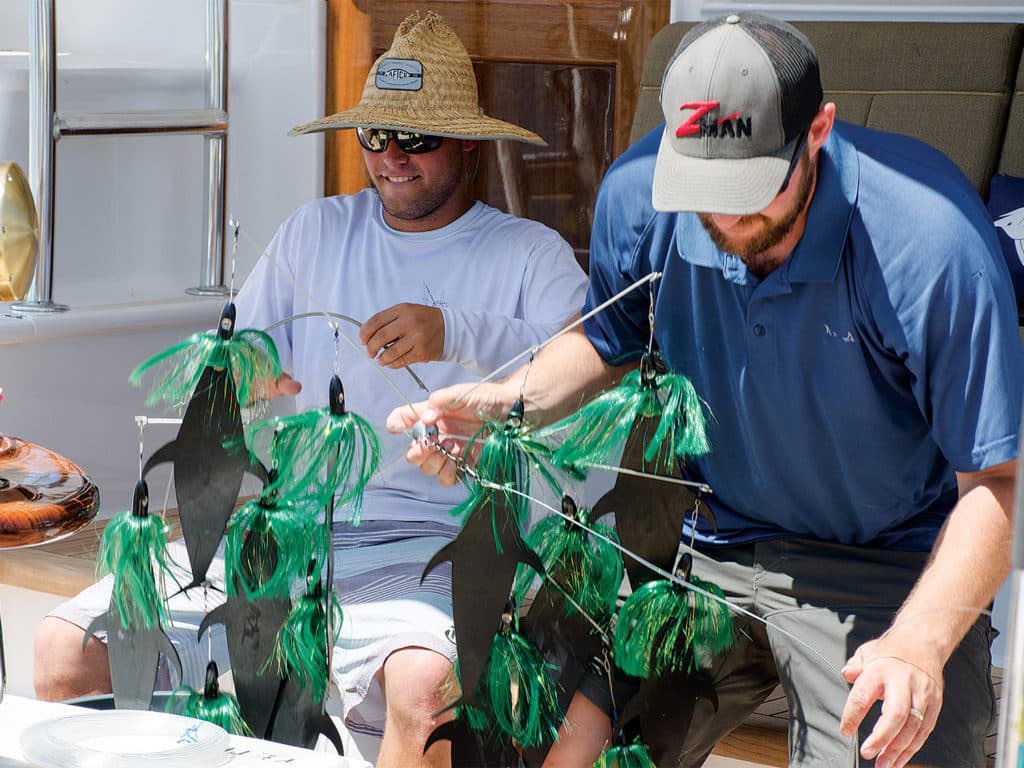
Retrieve: Direct or Indirect
The most accepted way to pull a dredge is from the cockpit, retrieving it with a heavy-duty electric reel. Lindgren-Pitmans have been the reel of choice by far, but there are many other comparable reels coming to market that do the job just as well. Center-consoles seem to favor a downrigger-type application, with a stout 4-foot boom extension to act as the outrigger. So it all depends on the rig you are working with.
Big boats using the block-and-tackle (A-frame) setup to retrieve their dredges will find it the most effective when going from the electric’s rod tip, up through a pulley attached to the outrigger pipe, down to the dredge, which is connected to another pulley that your dredge line goes through, and back up again to the outrigger, completing the triangle. This setup puts less strain on your dredge reel and makes it easier to retrieve the heavy dredge while underway. The setback to this is a slower retrieve, so some crews go direct: straight up to the outrigger, through a pulley and then directly down to the dredge.
This retrieves the dredge much quicker—which helps when you have a hungry billfish in it—when trolling at speeds less than 6 knots. Any faster and your dredge reel will labor more, retrieving your dredge no faster than the A-frame setup.
Read Next: Meet Roy Merritt in our exclusive interview.
All About the Hardware
When using monofilament at speed, the line tends to twist easily, so always use quality, heavy-duty ball-bearing swivels to help combat this problem, making sure you have the same type of swivel on your outrigger pulley should your line twist up. It’s also extremely important to use strong Ronstan- or Harken-brand pulleys, preferably with plastic frames instead of metal. A line twist meeting a metal-framed pulley will certainly put you at a higher risk of the dredge line getting chafed, or worse, cut off as you watch your dredge sink into the abyss. Pay close attention to the condition of your hardware and dredge line to ensure that you keep your dredge for the long haul. Neglecting these details or cheaping out on hardware could mean losing a $500-plus rig—not to mention a lot of time and effort—in an instant.
Dredges do help you raise more billfish. It has been proved time and time again, season after season, and they keep on giving. Experiment with different types of dredges to see what works best for you. Anytime you can be exposed to the professionals—either on a charter, a private boat, or hiring one as a freelancer—can help to skew the learning curve, saving you both time and money. It also will help get you dredge-fishing not only effectively, but immediately.
